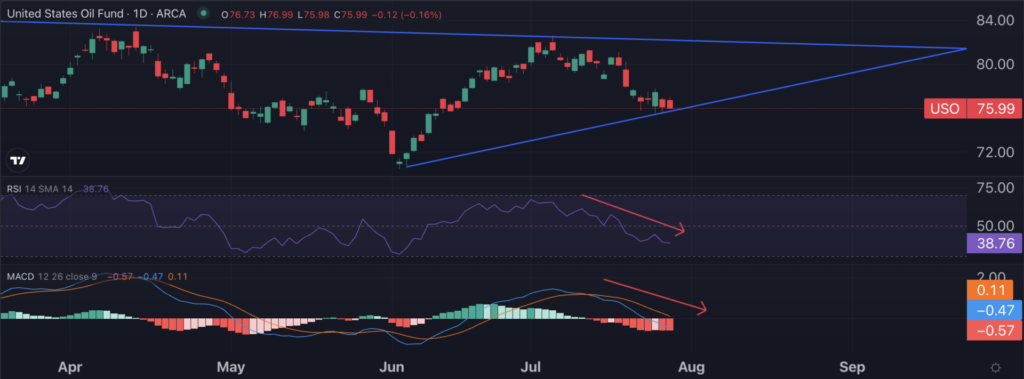Zinger Key Points
- Rising Middle East tensions fail to significantly impact oil prices.
- Chinese crude imports drop 11% in June, signaling struggles for the world's second largest economy.
- Join Chris Capre on Sunday at 1 PM ET to learn the short-term trading strategy built for chaotic, tariff-driven markets—and how to spot fast-moving setups in real time.
Oil prices continue to experience a sluggish trend, with West Texas Intermediate (WTI) light crude trading flat at just under $78 a barrel on Monday morning. This stagnation persists even as rising tensions in the Middle East have failed to significantly impact oil prices.
Middle East heats up again
On Sunday, Israel’s security cabinet authorized Prime Minister Benjamin Netanyahu‘s government to decide on the manner and timing of a response to a deadly rocket strike in the Israeli-occupied Golan Heights.
The attack, which killed 12 teenagers and children, has been attributed to the Lebanese armed group Hezbollah by both Israel and the United States.
Israel reported that an Iranian-made missile launched from southern Lebanon caused the deaths, holding Iranian-backed Hezbollah responsible.
However, Hezbollah has firmly denied any involvement in the strike, the deadliest in Israel or Israeli-controlled territory since Hamas’ October 7 assault, which initiated the Gaza conflict. In retaliation, Israeli jets targeted sites in southern Lebanon on Sunday.
Turkish President Tayyip Erdogan suggested over the weekend that Turkey might intervene in Israel, similar to its actions in Libya and Nagorno-Karabakh.
Vice President Kamala Harris, the Democratic presidential candidate, reiterated her “ironclad” support for Israel's security. The U.S. has been in talks with Israeli and Lebanese officials since the attack, seeking a diplomatic solution. Secretary of State Antony Blinken stressed that Washington aims to avoid further escalation of the conflict.
Reuters reported Monday morning that Israel aims to weaken Hezbollah without triggering a full-scale war in the Middle East. However, the situation remains highly volatile.
China’s Crude Oil Imports Struggle
Chinese crude oil imports continue to decline, indicating a struggling recovery in the world’s second-largest economy.
Crude oil imports in China fell by 11% in June 2024 compared to the same month in 2023, amid weak fuel demand and lower run rates at independent refineries. This represents the sharpest year-over-year decline in crude imports since June 2022.
In June, crude imports totaled 46.45 million metric tons, or approximately 11.3 million barrels per day (bpd). The average utilization rate of independent refineries in Shandong fell to 52% in June, the lowest since the pandemic began in 2020, according to local information provider JLC cited by S&P Global. The utilization rate was previously lower, at 43.8% in February 2020.
In the first half of 2024, crude arrivals also dropped, by 2.3% compared to the first half of last year, according to data from China's General Administration of Customs.
Oil Technical Analysis: Breakout Looms
“Oil prices have been trading in a narrowing range, or a triangle pattern, for over a year now,” wrote Bank of America Technical Strategist Paul Ciana, in a note shared Monday.
A technical triangle pattern is a chart formation indicating consolidation and potential breakout, formed by converging trendlines representing the asset’s highs and lows.
Bank of America estimates a breakout in crude prices between August and October 2024.
The current wave count links this pattern to the urban legend of the Bermuda Triangle, where things mysteriously disappear. Ciana suggests that a loss of macro risk premium, global demand, and/or supply cut hopes could lead to a decline in oil prices to $63 or $60 a barrel by the end of 2024.
A weekly close in Brent below $78 “would look like a bearish triangle breakdown,” Ciana stated. Conversely, bulls must push oil prices higher. A weekly close above $89 per barrel could trigger a bullish surge to $105 per barrel.
The United States Oil Fund USO, which closely tracks the performance of the WTI light crude, has risen 13% year to date, yet it is down by over 4% in July.
Chart: Oil Prices In A Triangle Pattern, With Momentum Weakening

Image: Benzinga Pro
Read Next:
Image created using artificial intelligence via Midjourney.
Edge Rankings
Price Trend
© 2025 Benzinga.com. Benzinga does not provide investment advice. All rights reserved.
Trade confidently with insights and alerts from analyst ratings, free reports and breaking news that affects the stocks you care about.